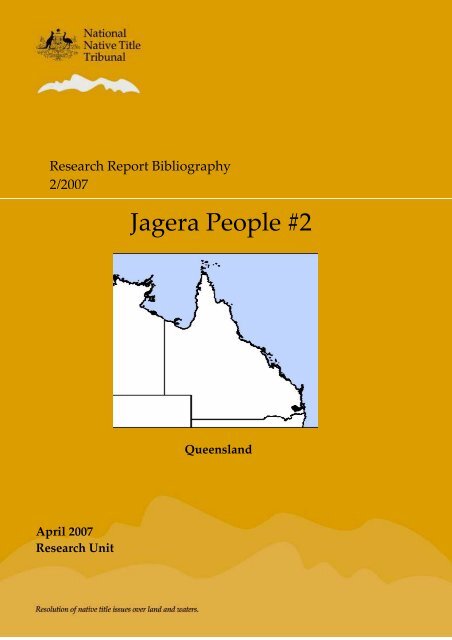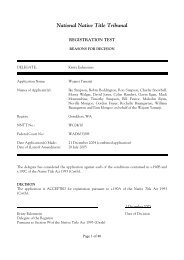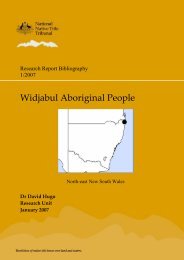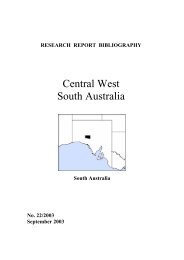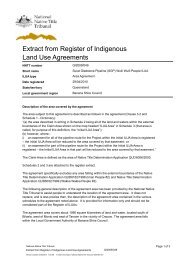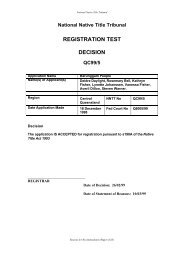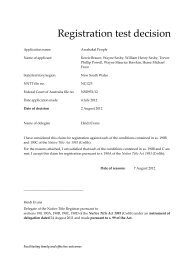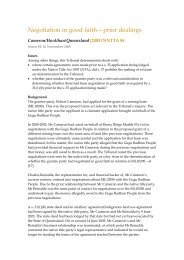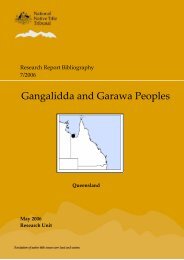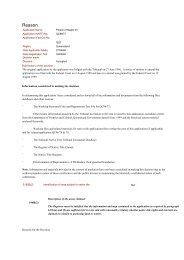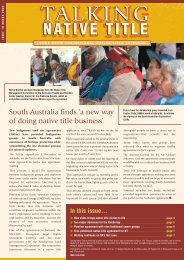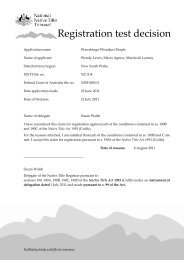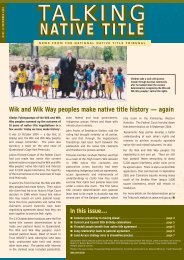Jagera People #2 - National Native Title Tribunal
Jagera People #2 - National Native Title Tribunal
Jagera People #2 - National Native Title Tribunal
Create successful ePaper yourself
Turn your PDF publications into a flip-book with our unique Google optimized e-Paper software.
Research Report Bibliography<br />
2/2007<br />
<strong>Jagera</strong> <strong>People</strong> <strong>#2</strong><br />
Queensland<br />
April 2007<br />
Research Unit
Note: This bibliographic series is produced for general library viewing from<br />
reports prepared by the <strong>Tribunal</strong> for parties to native title mediations. The<br />
bibliographies are also reproduced on the <strong>Tribunal</strong>’s website:<br />
www.nntt.gov.au<br />
© Commonwealth of Australia 2006<br />
This work is copyright. It may be reproduced in whole or in part for study or<br />
training purposes if an acknowledgment of the source is included. Such use<br />
must not be for the purposes of sale or commercial exploitation.<br />
Subject to the Copyright Act, reproduction, storage in a retrieval system or<br />
transmission in any form by any means of any part of the work other than for<br />
the purposes above is not permitted without written permission.<br />
Information about this report and requests and inquiries concerning<br />
reproduction should be addressed to, Manager, Research Unit, <strong>National</strong><br />
<strong>Native</strong> <strong>Title</strong> <strong>Tribunal</strong>, GPO Box 9973, Perth WA 6484.<br />
Editor of the Research Report Series: Research Unit<br />
Assistance is also acknowledged from NNTT Library Services, AIATSIS<br />
Library and the Research Unit’s Production Team.<br />
Telephone: (08) 9268 7272<br />
Facsimile: (08) 9268 7299<br />
E-mail: reports@nntt.gov.au<br />
Web site: www.nntt.gov.au<br />
ISSN: 1448-983X<br />
TITLE: Research Report Bibliographies
Bibliography <strong>Jagera</strong> <strong>People</strong> <strong>#2</strong><br />
Introduction<br />
The <strong>Tribunal</strong>’s Research Unit prepares bibliographies as a ready<br />
reference for anyone wanting to locate readily available, published<br />
material about Indigenous Australian people within a particular<br />
region or locality. The bibliographies are produced for general library<br />
use from reports prepared by the <strong>Tribunal</strong> for parties to native title<br />
mediations. The bibliographies are not exhaustive reference lists<br />
about any particular Indigenous group, nor is the published material<br />
necessarily an accurate or insightful report of Indigenous society. The<br />
Research Unit may update bibliographies from time to time, usually<br />
because a new research report has been reproduced for parties to<br />
mediation.<br />
It should be noted that the contents and production of these reports<br />
are governed by time and resource constraints. They are often<br />
prepared in four to eight weeks by a single research officer with some<br />
input from a research assistant and <strong>Tribunal</strong> librarian. Generally<br />
most of the references sought for these reports are available only from<br />
the AIATSIS library, which in turn has limited resources available to<br />
supply material. Therefore care is taken to request only that material<br />
which appears relevant to the scope of a particular report.<br />
Disclaimer: The bibliographies are a list of materials that have been<br />
used by the Research Unit of the <strong>Tribunal</strong> to provide background<br />
information for native title mediations. The <strong>Tribunal</strong> forms no view<br />
on the accuracy, completeness, or relevance of the reference material<br />
cited in these bibliographies. Most of this material is held at libraries<br />
and is available to the public. The <strong>Tribunal</strong> library may be able to<br />
assist in locating items.<br />
- 1 -
Bibliography <strong>Jagera</strong> <strong>People</strong> <strong>#2</strong><br />
<strong>Jagera</strong> <strong>People</strong> <strong>#2</strong> Report<br />
This report was produced by staff at the Research Unit of the <strong>National</strong><br />
<strong>Native</strong> <strong>Title</strong> <strong>Tribunal</strong> in order to assist with the mediation of a native<br />
title application by the <strong>Jagera</strong> people of south-east Queensland. Two<br />
native title claims have been made by the <strong>Jagera</strong> people to date:<br />
• <strong>Jagera</strong> <strong>People</strong> (QUD 6031/02; QC 02/33), a discontinued claim;<br />
and<br />
• <strong>Jagera</strong> <strong>People</strong> <strong>#2</strong> (QUD 6014/03; QC 03/15).<br />
The second of these, <strong>Jagera</strong> <strong>People</strong> <strong>#2</strong>, is the focus of this research<br />
report.<br />
The <strong>Jagera</strong> <strong>People</strong> <strong>#2</strong> claim area includes parts of Queensland’s most<br />
heavily populated region, including the Brisbane central business<br />
district, much of Brisbane’s southern and eastern suburbs, and the<br />
city of Ipswich.<br />
The upper north-western tip of the claim area is located just beyond<br />
the township of Esk, including parts of Lake Wivenhoe and the Esk<br />
State Forest. The boundary runs south-west to the lower northwestern<br />
corner of the claim area at Hampton. It then runs due south,<br />
to Gatton Creek at Postman’s Ridge, on the eastern outskirts of<br />
Toowoomba, which is the claim area’s western-most point.<br />
The boundary then follows a general south-easterly direction,<br />
following the Great Dividing Range to Cunningham’s Gap, its southwestern<br />
corner. It proceeds in a north-easterly direction, following the<br />
Cunningham Highway, through the Fassifern Valley, Boonah, then<br />
following Teviot Brook to the Logan River. It proceeds along the<br />
Logan River, through the south-eastern outskirts of greater Brisbane,<br />
almost to the mouth of the river, just south of Mt Cotton (the suburb).<br />
The boundary subsequently turns sharply north-west, past the Daisy<br />
Hill State Forest and Tingalpa Reservoir, before turning north-east<br />
again, through Wynnum and into Moreton Bay as far as Fisherman’s<br />
Island. The boundary incorporates a small area of Moreton Bay,<br />
- 2 -
Bibliography <strong>Jagera</strong> <strong>People</strong> <strong>#2</strong><br />
which includes the mouth of the Brisbane River, the Port of Brisbane,<br />
and Brisbane Airport. It returns inland at Boondall.<br />
The boundary line then runs south-west, joining with the Brisbane<br />
River, following that watercourse just past the Brisbane central<br />
business district. It follows the river south-west, through Brisbane’s<br />
south-western suburbs, and the northern suburbs of Ipswich. Here,<br />
the river (and boundary) turns north-west to Lake Wivenhoe, leading<br />
back to the upper north-western corner of the claim area near Esk.<br />
This report is based on publicly and readily available information that<br />
describes the identity and/or location of the <strong>Jagera</strong> <strong>People</strong> of southeast<br />
Queensland, in relation to the areas claimed in <strong>Jagera</strong> # 2 (QUD<br />
6014/03; QC 03/15).<br />
Research Method<br />
The content and production of these reports are governed by time<br />
and resource constraints. They are usually prepared in six weeks by a<br />
single research officer with some input from a research assistant and a<br />
<strong>Tribunal</strong> librarian.<br />
The material used for these reports is derived largely from a search of<br />
the AIATSIS online catalogue. A large proportion of this material is<br />
available only from the AIATSIS library, which has limited resources<br />
available to supply material. Therefore care is taken to request only<br />
that material which appears relevant to the scope of a particular<br />
report.<br />
The <strong>Tribunal</strong> Library also has substantial holdings of reference<br />
material which is used where appropriate. In addition, a number of<br />
general references were used, including:<br />
• Capell, 1963, Linguistic Survey of Australia;<br />
• Horton, 1996, Aboriginal Australia;<br />
• Tindale, 1940, 'Distribution of Australian Aboriginal tribes: a field<br />
survey';<br />
- 3 -
Bibliography <strong>Jagera</strong> <strong>People</strong> <strong>#2</strong><br />
• Tindale, 1974, Aboriginal Tribes of Australia; and<br />
• Howitt, 1904, The <strong>Native</strong> Tribes of South-East Australia.<br />
This report contains summaries of information that is publicly<br />
available and relevant to the <strong>Jagera</strong> <strong>People</strong> <strong>#2</strong> native title application.<br />
The claim area covers a large proportion of the Brisbane metropolitan<br />
area, Ipswich, Gatton and the areas defined broadly by the Lockyer<br />
and Fassifern Valleys.<br />
Overlaps with the <strong>Jagera</strong> <strong>#2</strong> claim are depicted in Map 3 and feature<br />
the following applications:<br />
• Western Wakka Wakka <strong>People</strong> (QC 99/04); and<br />
• Turrbal <strong>People</strong> (QC 98/26).<br />
While the overlap presented by the Western Wakka Wakka claim is<br />
relatively small, the Overlap between the <strong>Jagera</strong> <strong>#2</strong> and the Turrbal<br />
claims is significant, partly because together they cover one of<br />
Australia’s most densely populated locations, and partly because the<br />
historical record often appears to refer to <strong>Jagera</strong> and Turrbal people<br />
interchangeably in relation to the identity of the original Aboriginal<br />
occupants of Brisbane, in the first instance, and the wider region of<br />
the <strong>Jagera</strong> <strong>#2</strong> claim area and beyond in the second. For this reason, a<br />
search was made for materials that referred to Jagara/<strong>Jagera</strong>, Turrbal<br />
and Ugarapul/Yugarabul, in so far as they related to the <strong>Jagera</strong> <strong>People</strong><br />
<strong>#2</strong> claim area or part thereof.<br />
Prior to commencing the report, a search was made of the AIATSIS<br />
library catalogue for publicly available written materials using the<br />
above names in a ‘language group’ search and a ‘words or phrase’<br />
search.<br />
Each record was examined to determine its likely relevance or<br />
usefulness. Materials with access restrictions were omitted as were<br />
foreign language materials, obvious apparent cataloguing errors,<br />
microforms, audio material and material that appeared to deal with<br />
- 4 -
Bibliography <strong>Jagera</strong> <strong>People</strong> <strong>#2</strong><br />
technical aspects of language or education curricula. The result of<br />
these searches is set out in the table below:<br />
Search term<br />
Raw<br />
result<br />
After<br />
filtering<br />
Notes<br />
Language Group: <strong>Jagera</strong> 0 0 Group name recognised by<br />
AIATSIS as ‘Jagara’<br />
Word or Phrase: <strong>Jagera</strong> 7 2<br />
Language Group: Jagara 118 60<br />
Word or Phrase: Jagara 125 0 No new hits<br />
Language Group: Turrbal 0 0 Turrbal not recorded by AIATSIS<br />
catalogue as language groups<br />
Word or Phrase: Turrbal 11 0 All hits covered by Jagara search<br />
Language Group: Ugarapul 0 0 Language name not recorded by<br />
AIATSIS<br />
Word or Phrase: Ugarapul 10 6<br />
Total 271 68<br />
In addition to the MURA search, a search was undertaken of the<br />
Department of Environment and Heritage library, Canberra, which<br />
supplied access to some Environmental Impact Study and heritage<br />
study documents pertaining to the area.<br />
- 5 -
Bibliography <strong>Jagera</strong> <strong>People</strong> <strong>#2</strong><br />
Bibliography<br />
Anonymous, 1897. ‘A tradition’. The Australasian Anthropological Journal 6: 125.<br />
Bell, E. circa 1946. Legends of the Coochin Valley. Bunyip Press, Brisbane.<br />
Bell, J. 1994. ‘We need people to say, yeah, why shouldn’t their languages be revived or<br />
maintained’ (Radio <strong>National</strong> Boyer Lecture, November 1993). Editions, Jan-Feb<br />
1994: 19-20, 27.<br />
Bull, J. 1957. ‘Tales from the scenic rim’. Walkabout 23(6): 38-40.<br />
Burger, A. 1979. Neville Bonner: a biography. Macmillan, South Melbourne.<br />
Brisbane History Group 1990. ‘Local, oral and placename history’. Brisbane History Group<br />
Papers No. 9.<br />
Buchanan, R. 1999. Logan: rich in history, young in spirit. A comprehensive history. Logan<br />
City Council, Logan.<br />
Capell, A. 1963. Linguistic Survey of Australia. AIAS, Canberra.<br />
Colliver, F. and F. P. Woolston 1978. “Aboriginals in the Brisbane area’. In G. K. D.<br />
Murphy (ed.), Brisbane Retrospect: eight aspects of Brisbane history: proceedings of a<br />
seminar conducted by the John Oxley Library, Centennial Hall, State Library of<br />
Queensland, 5-6 June 1976. Library Board of Queensland, Brisbane. pp. 58-88.<br />
Curr, E. M. 1887. The Australian Race: its origin, languages, customs, place of landing in<br />
Australia and the routes by which it spread itself over that continent, in four volumes,<br />
Government Printer, Melbourne, vol. III.<br />
Davidson, D.S. 1938a. A Preliminary Register of Australian Tribes and Hordes, The American<br />
Philosophical Society, Philadelphia.<br />
Davidson, D.S. 1938b. ‘An Ethnic Map of Australia’, Proceedings of the American<br />
Philosophical Society, vol. 79, no. 4.<br />
Elkin, A. P. 1945. Aboriginal Men of High Degree. University of Queensland Press, St Lucia.<br />
Evans, R. and C. Ferrier, 2004. Radical Brisbane: an unruly history. The Vulgar Press,<br />
Carlton North.<br />
Ford, R. and T. Blake 1998. Indigenous <strong>People</strong>s in Southeast Queensland: an annotated guide to<br />
ethno-historical resources. The Foundation for Aboriginal and Islander Research<br />
Action, Woolloongabba.<br />
Gregory, H. 1996. The Brisbane River Story: meanders through time. Australian Marine<br />
Conservation Society, Brisbane.<br />
- 6 -
Bibliography <strong>Jagera</strong> <strong>People</strong> <strong>#2</strong><br />
Hall, J. 1982. ‘Sitting on the crop of the bay: an historical and archaeological sketch of<br />
Aboriginal settlement and subsistence in Moreton Bay, Southeast Queensland’. In<br />
S. Bowdler (ed.), Proceedings of the 1980 Valla Conference on Australian Prehistory.<br />
Research School of Pacific Studies, Australian <strong>National</strong> University, Canberra.<br />
Hardcastle, T. W. 1946-47. ‘A vocabulary of the Yuggarabul language: spoken in the<br />
Boonah district’. Queensland Geographical Journal 51: 21-28.<br />
Hausfeld, R. G. 1960. ‘Aspects of Aboriginal station management’. MA Thesis, University<br />
of Sydney.<br />
Helon, G. W. 1998. Aboriginal Australia: register of tribe, clan horde, linguistic group, language<br />
names and AIATSIS language codes – including synonyms, misnomers and approximate<br />
locations. Centre for Historical, Aboriginal and International Research, Bundaberg.<br />
Holmer, N. M. 1983, Linguistic Survey of South-eastern Queensland, Department of<br />
Linguistics, Research School of Pacific Studies, Australian <strong>National</strong> University,<br />
Canberra.<br />
Horton, D. (ed.) 1994. The Encyclopaedia of Aboriginal Australia, Australian Institute of<br />
Aboriginal and Torres Strait Islander Studies, Canberra.<br />
Horton, D. 2000. Aboriginal Australia (map), Australian Institute of Aboriginal and Torres<br />
Strait Islander Studies, Canberra.<br />
Howitt, A. W. 1904 . The <strong>Native</strong> Tribes of South-East Australia. Aboriginal Studies Press,<br />
Canberra (1996 reprint).<br />
Jackson, G. K. 1938. ‘The Keperra Bora ring’. The Queensland Naturalist 10(5): 94-95.<br />
Jackson, L. C. 1992. ‘A preliminary sourcebook on the Ugarapul people of the Fassifern,<br />
south-eastern Queensland’. Unpublished report, AIATSIS Library MS 3164,<br />
Canberra.<br />
Jeffcoat, K. 1966. ‘Relics of the past’. The Gazette (Port Kembla), Christmas 1966: 6-10.<br />
Lang, J. D. 1864. Queensland, Australia; a highly eligible field for emigration, and the future<br />
cotton-field of Great Britain: with a disquisition on the origin, manners, and customs of<br />
the Aborigines. Edward Stanford, London.<br />
Lauer, P. K. 1988. ‘Mi-an-jin: Aboriginal lifeways on the Brisbane River’. Anthropological<br />
Society of Queensland Newsletter 181: 2-7.<br />
Lauterer, J. 1891. ‘An Aboriginal language’. The Queenslander, 21 March 1891, p.555.<br />
Lauterer, J. 1895. ‘Outlines of a grammar of the Yaggara, the language of the Yerongpan<br />
tribe on the sandy country between Brisbane and Ipswich. Australian and New<br />
Zealand Association for the advancement of science 6: 619-624.<br />
- 7 -
Bibliography <strong>Jagera</strong> <strong>People</strong> <strong>#2</strong><br />
Lauterer, J. 1897. ‘The Aboriginal languages of eastern Australia compared: a philological<br />
essay’. Proceedings of the Royal Society of Queensland 12: 11-16.<br />
Marks, E. N. 1968. ‘The preservation of Samford Bora grounds’. Journal of the Royal<br />
Historical Society of Queensland 8(3): 568-567.<br />
Mathews, R. H. 1907a. ‘Notes on the Aborigines of the Northern Territory, Western<br />
Australia and Queensland.’ Queensland Geographical Journal 22: 74-86.<br />
Mathews, R. H. 1907b. ‘Note on the social organisation of the Turrubul and adjacent<br />
tribes’. Man 7(11): 166-168.<br />
McCarthy, F. D. 1952. ‘Aboriginal rain-makers and their ways: part II’. The Australian<br />
Museum Magazine 10(9): 302-305.<br />
Moorwood, M. J. 1992. ‘Gatton Rock Art Site (KB:A01): its conservation and<br />
management’. Unpublished report to the Department of Environment and<br />
Heritage, Kenmore and North Quay.<br />
Oates, W.J. and L. Oates 1970. A Revised Linguistic Survey of Australia, Australian Institute<br />
of Aboriginal Studies, Canberra.<br />
Oates, L. 1975. 1973 Supplement to ‘A Revised Linguistic Survey of Australia’, Armidale<br />
Christian Book Centre, Armidale.<br />
O’Donnell, D. 1989. ‘The Ugarapul tribe of the Fassifern Valley’. Journal of the Royal<br />
Historical Society of Queensland 14(4): 149-160.<br />
O’Donnell, D. 1991. ‘White versus black in the Fassifern: extirpation of the Ugarapuls’.<br />
Social Analysis 9(4): 17-19.<br />
O’Grady, G. N., Voegelin, C. F. and F. M. Voegelin 1966. ‘Languages<br />
of the world: Indo-Pacific fascicle six’. Anthropological Linguistics<br />
8(2):1-197.<br />
O’Grady, G. N., Wurm, S. A. and K. L. Hale, 1966. Aboriginal<br />
Languages of Australia: a preliminary classification (map).<br />
University of Victoria, Victoria.<br />
Parliament of Australia, Senate, 1999. ‘Bonner, Mr Neville Thomas, AO’. In Hansard, 15<br />
February 1999, pp. 1837-1851.<br />
Petrie, C. C. 1904. Tom Petrie’s Reminiscences of Early Queensland. University of<br />
Queensland Press, St Lucia (1992 reprint).<br />
Pugsley, H. 1975. Looking Back Along the Fassifern Valley. Samuel Lee & Co, Stanthorpe.<br />
- 8 -
Bibliography <strong>Jagera</strong> <strong>People</strong> <strong>#2</strong><br />
Ridley, W. 1875. Kamilaroi and other Australian Languages. New South Wales Government<br />
Printer, Sydney.<br />
Roth, W. E. 1903-1910 (1984 facsimile edition). The Queensland Aborigines, Hesperian<br />
Press, Victoria Park, Vols. II-III.<br />
Steele, J. G. 1983. Aboriginal Pathways in Southeast Queensland and the Richmond River.<br />
University of Queensland Press, St Lucia.<br />
Thorpe, B. 2004. Remembering the Forgotten: a history of the Deebing Creek Aboriginal Mission<br />
in Queensland 1887-1995. Seaview Press, Henley Beach.<br />
Tindale, N. B. 1940. 'Distribution of Australian Aboriginal Tribes: A Field Survey', Royal<br />
Society of South Australia, 64(1).<br />
Tindale, N. B. 1974. Aboriginal Tribes of Australia: Their Terrain, Environmental Controls,<br />
Distribution, Limits, and Proper Names, University of California Press, Berkeley.<br />
Uhr, F. 2002. ‘September 12, 1843; the Battle of One Tree Hill – a turning point in the<br />
conquest of Moreton Bay’. Royal Historical Society of Queensland Journal 18(6): 241-<br />
255.<br />
Watson, F. J. 1940. ‘A vocabulary of the language of the Yugarabul lingual division of<br />
Australian aborigines and incidentally of the Turrubul sub-tribe at Brisbane’.<br />
Unpublished ms, AIATSIS, Canberra PMS 5355.<br />
Watson, F. J. 1944. ‘Vocabularies of four representative tribes of south eastern<br />
Queensland with grammatical notes thereof and some notes on manners and<br />
customs. Also a list of Aboriginal place names and their derivations.’ Journal of the<br />
Royal Geographical society of Australasia (Queensland) 48(34): special supplement.<br />
Winterbotham, L. P. 1957. ‘Gaiarbau’s story of the Jinibara tribe of south east Queensland<br />
(and its neighbours)’. Unpublished ms, AIATSIS Canberra MS45.<br />
Winterbotham, L. P. 1982. ‘The Gaiarbau Story’. Queensland Ethnohistory Transcripts 1(1):<br />
20-134.<br />
Wurm S. A., and Hattori, S. 1981. Language atlas of the Pacific area, Australian Academy of<br />
the Humanities in collaboration with the Japan Academy, Canberra.<br />
- 9 -
For more information about native title<br />
and services of the <strong>Tribunal</strong>, please contact<br />
the <strong>National</strong> <strong>Native</strong> <strong>Title</strong> <strong>Tribunal</strong><br />
GPO Box 9973 in your capital city on<br />
Freecall 1800 640 501. A wide variety of<br />
information is also available online at<br />
www.nntt.gov.au<br />
The <strong>National</strong> <strong>Native</strong> <strong>Title</strong> <strong>Tribunal</strong> has<br />
offices in Adelaide, Brisbane, Cairns, Darwin,<br />
Melbourne, Perth and Sydney.


